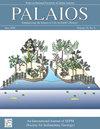从二维视图估计洞穴百分比的定量变异性:以沙特阿拉伯中部含地中海类地层为例
IF 1.5
4区 地球科学
Q2 GEOLOGY
引用次数: 4
摘要
摘要:本研究检查了从含海生烃地层(沙特阿拉伯中部Hanifa组)切割的直径15.24厘米、长度17.1厘米的岩芯的计算机断层扫描(CT)扫描,以探索使用2D视图估计洞穴百分比的定量变化。该核心的裁剪的四边形棱镜允许在两个垂直方向上的202个2D切片和165个水平2D切片。在这个被裁剪的四棱柱体中,类海生物的体积占总体积的20.0%(洞穴百分比)。二维垂直切片估计的洞穴百分比从11.8%到30.3%不等,两个垂直方向的平均值分别为19.9%±3.3%和19.6%±3.9%,变异系数分别为17%和20%。当使用水平切片估计洞穴百分比时,发现范围更宽,变异性略大(洞穴百分比范围从6.1%到33.1%,平均值为19.8%±6.5%,变异系数为33.1%)。然而,方差分析结果表明,洞穴百分比在垂直和水平切片之间的分布没有统计学上的显著差异。对随机选择的CT扫描切片将如何表示洞穴百分比的测试表明,即使是五个随机选择的切片也可以保持与CT扫描的实际洞穴百分比相当的平均值。基于这些结果,我们提出了一种统计方法来量化与从2D视图估计洞穴百分比相关的不确定性,这是完全理解从2D视图估算洞穴百分比(和生物扰动强度)可变性的重要一步。本文章由计算机程序翻译,如有差异,请以英文原文为准。
QUANTITATIVE VARIABILITY OF BURROW PERCENTAGE ESTIMATED FROM 2D VIEWS: EXAMPLE FROM THALASSINOIDES-BEARING STRATA, CENTRAL SAUDI ARABIA
Abstract: This study examines computed tomography (CT) scans of a 15.24-cm diameter and 17.1-cm length core cut from Thalassinoides -bearing strata (Hanifa Formation, central Saudi Arabia) to explore the quantitative variability in burrow percentage when estimated using 2D views. A cropped quadrangular prism of this core allowed 202 2D slices in two vertical orientations and 165 horizontal 2D slices. Thalassinoides volume represents 20.0% (burrow percentage) of the total volume within this cropped quadrangular prism. The estimated burrow percentage by the 2D vertical slices varies from 11.8% to 30.3% with a mean value of 19.9% ± 3.3% and 19.6% ± 3.9%, and coefficients of variation of 17% and 20%, for the two vertical orientations. A wider range and slightly more variability are found when estimated burrow percentage using the horizontal slices (burrow percentage range from 6.1% to 33.1% with a mean value of 19.8% ± 6.5% and coefficient of variation of 33.1%). However, analysis of variance results indicated no statistically significant difference between the distribution of the burrow percentage among vertical and horizontal slices. A test of how randomly selected slices of the CT scan would represent the burrow percentage indicated that even five randomly selected slices could retain a mean comparable to the actual burrow percentage of the CT scan. Based on these results, we suggested a statistical way to quantify the uncertainty associated with estimating the burrow percentage from 2D views, an important step toward a complete understanding of variability in burrow percentage (and bioturbation intensity) when estimated from 2D views.
求助全文
通过发布文献求助,成功后即可免费获取论文全文。
去求助
来源期刊

Palaios
地学-地质学
CiteScore
2.80
自引率
12.50%
发文量
40
审稿时长
6 months
期刊介绍:
PALAIOS is a monthly journal, founded in 1986, dedicated to emphasizing the impact of life on Earth''s history as recorded in the paleontological and sedimentological records. PALAIOS disseminates information to an international spectrum of geologists and biologists interested in a broad range of topics, including, but not limited to, biogeochemistry, ichnology, paleoclimatology, paleoecology, paleoceanography, sedimentology, stratigraphy, geomicrobiology, paleobiogeochemistry, and astrobiology.
PALAIOS publishes original papers that emphasize using paleontology to answer important geological and biological questions that further our understanding of Earth history. Accordingly, manuscripts whose subject matter and conclusions have broader geologic implications are much more likely to be selected for publication. Given that the purpose of PALAIOS is to generate enthusiasm for paleontology among a broad spectrum of readers, the editors request the following: titles that generate immediate interest; abstracts that emphasize important conclusions; illustrations of professional caliber used in place of words; and lively, yet scholarly, text.
 求助内容:
求助内容: 应助结果提醒方式:
应助结果提醒方式:


